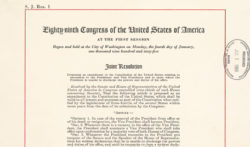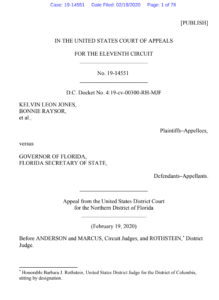The Constitutional Law Song–With Banjo, Fiddle & Ukulele– is something:
(Spotted via Ben Davis on a mailing list)
The Constitutional Law Song–With Banjo, Fiddle & Ukulele– is something:
(Spotted via Ben Davis on a mailing list)
 I think the odds of Vice President Pence invoking the 25th amendment are somewhat lower than the odds of the Knicks winning the NBA championship this year,1 but the the highly theoretical prospect raises a tidy legal question.
I think the odds of Vice President Pence invoking the 25th amendment are somewhat lower than the odds of the Knicks winning the NBA championship this year,1 but the the highly theoretical prospect raises a tidy legal question.
Recall that Section 4 of the 25th Amendment states that,
Whenever the Vice President and a majority of either the principal officers of the executive departments or of such other body as Congress may by law provide, transmit to the President pro tempore of the Senate and the Speaker of the House of Representatives their written declaration that the President is unable to discharge the powers and duties of his office, the Vice President shall immediately assume the powers and duties of the office as Acting President.
Thereafter, when the President transmits to the President pro tempore of the Senate and the Speaker of the House of Representatives his written declaration that no inability exists, he shall resume the powers and duties of his office unless the Vice President and a majority of either the principal officers of the executive department or of such other body as Congress may by law provide, transmit within four days to the President pro tempore of the Senate and the Speaker of the House of Representatives their written declaration that the President is unable to discharge the powers and duties of his office. Thereupon Congress shall decide the issue, assembling within forty–eight hours for that purpose if not in session. If the Congress within twenty–one days after receipt of the latter written declaration, or, if Congress is not in session, within twenty–one days after Congress is required to assemble, determines by two-thirds vote of both Houses that the President is unable to discharge the powers and duties of his office, the Vice President shall continue to discharge the same as Acting President; otherwise, the President shall resume the powers and duties of his office.
No one imagined we’d have so many acting Cabinet Secretaries as we do now. I think we are up to five out of fifteen at present (counting only true heads of major executive departments and not other ‘Cabinet-level’ appointees), with more perhaps on the way
So the legal mind starts to wonder: Do Acting Secretaries get to vote under the 25th Amendment? And if not, does the size of the majority required (eight if all count) go down?
The short answer is that it’s most likely that Acting Secretaries get to vote:
The Congressional Research Service did a report, Thomas H. Neale, CRS, Presidential Disability Under the Twenty-Fifth Amendment: Constitutional Provisions and Perspectives for Congress (Updated November 5, 2018) which tells you provably much more than you want to know about the history and mechanics of the 25th. On page 11 it says,
Respecting details of the Cabinet’s participation, the House Judiciary Committee’s 1965 report on the proposed amendment stated that in the event of a vacancy in any of the Cabinet offices, “the acting head would be authorized to participate in a presidential disability determination,” while [John D,] Feerick [a leading scholar of presidential disability and succession] notes that the amendment’s supporters asserted that recess appointees to Cabinet offices would also be eligible to participate in a Section 4 deliberation.
This generally accords with a 1985 memo from the Office of Legal Counsel (the agency in the Justice Department charged with opining on such issues):
We believe that the “principal officers of the executive departments” for the purposes of the Twenty-Fifth Amendment are the heads of the departments listed in 5 U.S.C. § 101, presently the Secretary of State, Secretary of the Treasury, Secretary of Defense, Attorney General, Secretary of the Interior, Secretary of Agriculture, Secretary of Commerce, Secretary of Labor, Secretary of Health and Human Services, Secretary of Housing and Urban Development, Secretary of Transportation, Secretary of Energy, and Secretary of Education. This view is supported by the legislative history of the Amendment. See H.R. Rep. No. 203, 89th Cong., 1st Sess. 3 (1965); 111 Cong. Rec. 7938 (1965) (Rep. Waggoner); id. at 7941 (Rep. Poff); id. at 7944 45 (Rep. Webster); id. at 7952, 7954 (Rep. Gilbert); id. at 3282-83 (Sen. Hart and Sen. Bayh).
At present, this list is identical to the list of statutory Presidential successors under 3 U.S.C. § 19, except that it does not include the Speaker of the House of Representatives or the President pro tempore of the Senate. Furthermore, although the acting heads of departments and recess appointees are not Presidential successors, see 3 U.S.C. § 19(e), the legislative history of the Twenty- Fifth .Amendment suggests that, in the event of a vacancy in office or the absence or disability of a department head, the acting department head, at least at the level of undersecretary, principal deputy, or recess appointee might be entitled to participate in determinations of Presidential disability. See H.R. Rep. No. 203 at 3; 111 Cong. Rec. 15380 (1965) (Sen. Kennedy — acting heads); id. at 3284 (Sen. Hart and Sen. Bayh — interim appointees). But see id. at 3284 (Sen. Bayh — acting heads not entitled to participate). As a practical matter, and in order to avoid any doubt regarding the sufficiency of any given declaration, it would be desirable to obtain the assent of a sufficient number of officials to satisfy any definition of the term “principal officers of the executive departments.”
Of course, if the vote were to happen, and the votes of the Acting Secretaries were needed to make a majority, that would be an issue that Trump could take to court. By the time it could work its way to the Supreme Court, the issue would likely be moot.
 U.S. Constitution Article II, Section 3, cl. 2 is having its moment in the sun. This clause says that the President
U.S. Constitution Article II, Section 3, cl. 2 is having its moment in the sun. This clause says that the President
may, on extraordinary Occasions, convene both Houses, or either of them, and in Case of Disagreement between them, with Respect to the Time of Adjournment, he may adjourn them to such Time as he shall think proper;
Lots of folks are suggesting that if the Senate is being difficult about confirming Biden’s cabinet – as many expect it will be – the response to this piece of unprecedented Constitutional hardball, would be … more hardball.
The idea is that the Speaker manufactures a disagreement about adjournment between the House and Senate. Biden then prorogues Congress for, say, 11 business days. And during those 11 days — in full compliance with the rather arbitrary 10-day minimum for an intra-session recess imposed by National Labor Relations Board v. Noel Canning — Biden would then use his recess appointment power, Art II, Section 2, para 3:
The President shall have Power to fill up all Vacancies that may happen during the Recess of the Senate, by granting Commissions which shall expire at the End of their next Session.
Not a very Bidenesque thing to do, but it would teach Mitch McConnell not to jerk him around.
Note: By modern convention a ‘session’ of congress runs for a year from January to January the following year. So a commission that expires “at the end of the next session” would in the ordinary course last for the two-year life of the current Congress. I imagine it would take both houses to change that, but I don’t know for sure.
Another zinger from the Lincoln Project:
If I had to bet, I’d bet that the Customs and Border Patrol is the paramilitary force most likely to become the modern Brown Shirts. They’re the only one with anything close to the numbers other than the armed services themselves, and they’re the ones with a toxic brew of resentment and racism ripe for exploitation by the ‘right’ sort of leadership.
Basically, armed feds fall into a few (over)broad groups:
First, the uniformed military. This is of course the largest and best-armed, group. If it decides to occupy the field, every other group on this list will get out of its way: The Pentagon has troops, tanks, attack helicopters, nukes even. But by and and large I’m not real worried about the military being deployed as a domestic occupation force; most of the services, the Air Force perhaps excepted, appear to have pretty strong cultures of non-partisanship that would make that unlikely except in a spot support role like when in in 1957 Eisenhower sent in 1,000 soldiers of the 327th Airborne Battle Group of the 101st Airborne Division to Little Rock to enforce school integration (recall that Governor Orval Faubus had deployed the Arkansas National Guard to support the segregationists).
That said, there are things that could give you pause. One is the shameful role of the Chairman of the Joint Chiefs last night, Gen. Mark Milley, who chose to join Trump on his little jaunt across the street while in combat fatigues. In a hopeful sign Gen. Milley understands he went too far, he’s now trying to, er, walk it back.
Another is the culture of the Air Force (and perhaps its calf, the Space Force), which has become deeply sectarian; sectarianism certainly doesn’t equal willingness to trample protests, but it does signal a disinterest in Constitutional principles, which is a worry.
Another worrying thing, maybe the most worrying on this sub-list of caveats, is the latest report that military helicopters were deployed yesterday to fly low to ‘discourage’ protesters:
A Black Hawk helicopter, followed by a smaller medical evacuation helicopter, dropped to rooftop level with their search lights aimed at the crowd. Tree limbs snapped, nearly hitting several people. Signs were torn from the sides of buildings. Some protesters looked up, while others ran into doorways. The downward force of air from the rotors was deafening.
The helicopters were performing a “show of force” — a standard tactic used by military aircraft in combat zones to scatter insurgents. The maneuvers were personally directed by the highest echelons of the Washington National Guard, according to a military official with direct knowledge of the situation. The Guard did not respond to a request for comment.
That reportedly caused pushback from retired military leaders, and even rumblings in the ranks.
It’s maybe worth pointing out that the D.C. National Guard, which isn’t a very big force, is unique in that it reports to the President directly rather than to any Governor, due to Washington D.C.’s semi-colonial status. The Mayor of Washington D.C., its highest elected local official, is not in the Guard’s chain of command. Rather, at least according to Wikipedia,
The D.C. National Guard is the only National Guard that reports only to the president.
Supervision and control of D.C. National Guard was delegated by the president to the defense secretary pursuant to Executive Order 10030, 26 January 1949 with authority to designate National Military Establishment officials to administer affairs of the D.C. National Guard. The Army secretary was directed to act in all matters pertaining to the ground component, and the Air Force secretary was directed to act in all matters pertaining to the air component.
The D.C. National Guard is the only U.S. military force empowered to carry out federal functions in a state or, in this case, a district. Those functions range from limited actions during non-emergency situations to full scale law enforcement of martial law when local law enforcement officials can no longer maintain civil control. The National Guard may be called into federal service in response to a call by the president or Congress.
When the D.C. National Guard is called to federal service, the president serves as commander-in-chief. The federal mission assigned to the U.S. National Guard is “To provide properly trained and equipped units for prompt mobilization for war, National emergency or as otherwise needed.”
Thus, the willingness to deploy the DC National Guard aggressively against civilians could be a tell for what is in store with more regular armed forces; on the other hand, orders to other military groups will have to go through a different chain of command. And they are busy signalling hard they have no appetite for it. Certainly, if I’m wrong in my cautious optimism about the fundamental character of our armed forces, we’re in a whole different space from the universe any of us are used to navigating.
Second on the list of armed feds are the CIA’s private armies. Who knows how many there are, where they are, what their nationalities are, what their missions are? All important questions, but for present purposes the key point is that they are abroad. Any attempt to bring one of these home would turn liberals into Second Amendment partisans (in both senses of that word). But it’s not going to happen.
Third — and where I was originally headed with all this before getting blown off course by the DC National Guard’s helicopters — a plethora of federal civilian police and paramilitary forces. There’s a list of agencies and units of agencies at Wikipedia but I doubt it’s complete. There’s a lot of these groups — the Bureau of Justice Statistics counted 83 a few years ago, but that number includes police forces in the military. Whatever the number, the key thing here is that in the grand scheme of things — occupying a big country — most of these groups are quite small. Indeed, four years ago (I can’t find better data), about two-thirds of the 100,000 armed civilian feds worked for one of four agencies: Customs and Border Protection (33%), the Federal Bureau of Prisons (14%) [see yesterday’s post], the FBI (10%), or Immigration and Customs Enforcement (9%).
I have never been a cheerleader for the FBI, but their training is light-years ahead of the CBP.  It’s the CBP that has the numbers, that has the recruiting crisis, that is losing the good officers and stuck with what’s left, that has disgusting bigoted secret social media groups, and a leadership notable for corruption, misconduct and a toxic culture. All of which makes a modern brownshirt movement all too easy to imagine. Please don’t misunderstand: I’m not saying it’s inevitable; I’m not giving odds. I’m just saying it’s something that has seemed like something worth watching out for pretty much since Trump got elected.
It’s the CBP that has the numbers, that has the recruiting crisis, that is losing the good officers and stuck with what’s left, that has disgusting bigoted secret social media groups, and a leadership notable for corruption, misconduct and a toxic culture. All of which makes a modern brownshirt movement all too easy to imagine. Please don’t misunderstand: I’m not saying it’s inevitable; I’m not giving odds. I’m just saying it’s something that has seemed like something worth watching out for pretty much since Trump got elected.
All this is context for what I find to be the disturbing news that Trump is sending the CBP into cities for counter-citizen activities. The head of the CBP, an ‘acting’ naturally so as to avoid the necessity of Senate confirmation, tweeted a picture of masses of uniformed CBP officers, stating
CBP personnel have deployed to the National Capital Region to assist law enforcement partners. These “protests” have devolved into chaos & acts of domestic terrorism by groups of radicals & agitators. @CBP is answering the call and will work to keep DC safe.
This “chaos … radicals & agitators” talk is brownshirt language. The implications were not lost on AOC who called it “dangerous”.
It is dangerous. A lot of what’s going right now feels dangerous.
 Today the 11th Circuit issued a per curiam decision on Kelvin Leon Jones, et al. v. Governor of Florida, et al., the Amendment 4 felon-voting case, which holds that strict scrutiny applies and that the Florida Legislature’s decision to require felons to pay all the fees and charges associated with their cases is, in the case of indigents, a violation of Equal Protection.
Today the 11th Circuit issued a per curiam decision on Kelvin Leon Jones, et al. v. Governor of Florida, et al., the Amendment 4 felon-voting case, which holds that strict scrutiny applies and that the Florida Legislature’s decision to require felons to pay all the fees and charges associated with their cases is, in the case of indigents, a violation of Equal Protection.
It’s a nicely done opinion but per curiam or not it has got en banc written all over it. The panel was Judge R. Lanier Anderson III (nominated — to the then-5th Circuit — by Jimmy Carter), Judge Stanley Marcus (nominated by Ronald Reagan to the District Court, and by Bill Clinton to the Court of Appeal), and Judge Barbara Rothstein (District Judge, Western District of Washington, sitting by designation; appointed by Jimmy Carter).
All three judges were appointed to their current seats by Democrats, but the 11th Circuit as a whole skews Republican. All three have senior status–I didn’t even know that appellate courts allowed a majority of senior judges on a panel, much less all three. One is a visiting Judge from Washington State (fresh from a visit to Washington, D.C., which may have lead to the incorrect attribution of her home court on the first page of the opinion). All this spells e-n b-a-n-c to me. So we haven’t heard the end of this case yet. That said, the panel’s affirmation of (most of) the injunction might last through to the 2020 election.